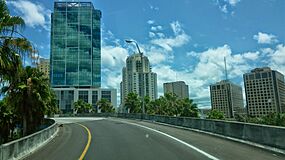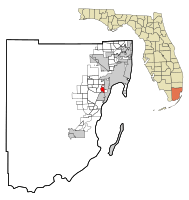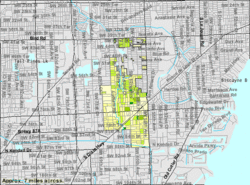South Miami, Florida facts for kids
Quick facts for kids
South Miami, Florida
|
|||
|---|---|---|---|
| City of South Miami | |||
 |
|||
|
|||
| Nickname(s):
SoMi
|
|||
| Motto(s):
The City of Pleasant Living
|
|||

Location in Miami-Dade County and the state of Florida
|
|||

U.S. Census Bureau map showing city limits
|
|||
| Country | |||
| State | |||
| County | |||
| Settled | 1897 | ||
| Incorporated | June 24, 1927 | ||
| Government | |||
| • Type | Council-Manager | ||
| Area | |||
| • Total | 2.31 sq mi (5.98 km2) | ||
| • Land | 2.27 sq mi (5.87 km2) | ||
| • Water | 0.04 sq mi (0.11 km2) | ||
| Elevation | 10 ft (3 m) | ||
| Population
(2020)
|
|||
| • Total | 12,026 | ||
| • Density | 5,304.81/sq mi (2,048.07/km2) | ||
| Time zone | UTC-5 (EST) | ||
| • Summer (DST) | UTC-4 (EDT) | ||
| ZIP Codes |
33143, 33155 (Miami)
|
||
| Area code(s) | 305, 786, 645 | ||
| FIPS code | 12-67550 | ||
| GNIS feature ID | 0291395 | ||
South Miami is a city in Miami-Dade County, Florida, United States. It is part of the larger Miami metropolitan area in South Florida. In 2020, about 12,026 people lived there.
Contents
A Look Back at History
Long ago, Native American tribes like the Tequesta, Calusa, and Jaega lived in South Florida. Later, pioneers moved into the area.
Early Settlers and Names
In 1896, Wilson Alexander Larkins and his family arrived in the area. He bought land and built a home and the first general store in 1898. He also started the first post office and named the area "Manila." However, most settlers preferred to call the community "Larkins" to honor him.
A train station was built in 1904. That same year, John Moses Dowling built the first house within what is now South Miami. His son-in-law opened the first store on the west side of the tracks, called the White Palace Grocery.
Important Families and Buildings
Many historic families have buildings and streets named after them. For example, Dorn Avenue is named after Harold W. Dorn and his brother Robert. They moved to the area in 1910 and grew mangoes and avocados.
In 1925, the Dorn brothers built the Riviera Theatre. Later, it became a bakery called Holsum Bakery. Many people who lived in South Miami for a long time remember the smell of fresh bread from this bakery.
Madison Square Community
Marshall Williamson was the first African-American to buy land in the Larkins area. He moved from Madison, Florida. He built his home and let it be used for church services. In 1916, he gave land for the St. John's AME Church, which was one of the first churches in the black community. He also donated land for the J. R. E. Lee School. Because of his kindness, the black neighborhood was called Madison Square, after his hometown. Marshall Williamson Park is named after him.
Becoming the City of South Miami
In 1926, residents wanted their area to become an official town. They chose the name "Town of South Miami" because of the growing city to their north. The original town was much larger than it is today.
That same year, the University of Miami opened nearby. Also, the Cambridge Lawns neighborhood was founded. Its historic district, with about 30 homes built in the Tudor Revival and Mediterranean revival styles, was recognized as historic in 2005.
South Miami faced challenges from strong storms. In 1926, a big hurricane caused a lot of damage. The train station burned down. Later, Hurricane Andrew in 1992 and Hurricane Bonnie (1998) also caused damage.
On June 25, 1927, W. A. Forster became South Miami's first mayor.
Over the years, the city's size was reduced several times. This is why South Miami has some of the most unusual borders of any city in Miami-Dade County today.
A Community Spirit
Jack Block was mayor from 1968 to 1984. He described South Miami as a "friendly community." He shared a story about a time when the community came together:
I moved here March 6, 1956, and lived in the same house. I love this city. There are times you get aggravated with what is going on. It's a friendly community. Do you remember when they had the riots down in Overtown back at Nixon's first inauguration. They had the Convention down here. Everywhere in town there were riots going on. In the city of South Miami we had a big barbeque which was held in the black area in one of the black parks. Where the Jaycees and myself, I cooked ribs all night long, and all the white people were there serving the black community. And we had no problems. When there were police problems the black community would get hold of me and tell me, "There's a car load of people coming in from Coconut Grove," and we could tell the police. That's the way this community is. It's a close-knit community. Black people living with white, you don't get that anywhere else.
In 1990, Catherine McCann became South Miami's first female Mayor. She helped clean up the city after Hurricane Andrew.
Global Connections
In 2000, South Miami started forming partnerships with cities around the world. This helps with cultural and economic development. South Miami is part of Sister Cities International. It has relationships with Grand Turk in the Turks and Caicos Islands and Basseterre in Saint Kitts and Nevis. In 2018, South Miami also became a "Sister-City" with the Municipio de Medellin, Colombia.
Geography and Location
South Miami is located at 25°42′37″N 80°17′43″W / 25.71028°N 80.29528°W. It shares borders with Coral Gables to the east, Pinecrest to the south, and Glenvar Heights and Coral Terrace to the west and north.
U.S. Route 1 (South Dixie Highway) runs through the city. It leads northeast to Downtown Miami and southwest to Homestead.
The city covers about 2.3 square miles (5.98 square kilometers). Most of this area is land, with a small part being water.
Neighboring Areas
- Glenvar Heights / Unincorporated Miami-Dade County / Coral Terrace
- Coral Terrace


 Coral Gables
Coral Gables - Unincorporated Miami-Dade County / Glenvar Heights

 Coral Gables, Unincorporated Miami-Dade County
Coral Gables, Unincorporated Miami-Dade County - Glenvar Heights, Pinecrest


 Coral Gables
Coral Gables - Glenvar Heights / Pinecrest
Population and People
| Historical population | |||
|---|---|---|---|
| Census | Pop. | %± | |
| 1930 | 1,160 | — | |
| 1940 | 2,408 | 107.6% | |
| 1950 | 4,809 | 99.7% | |
| 1960 | 9,846 | 104.7% | |
| 1970 | 11,780 | 19.6% | |
| 1980 | 10,895 | −7.5% | |
| 1990 | 10,404 | −4.5% | |
| 2000 | 10,741 | 3.2% | |
| 2010 | 11,657 | 8.5% | |
| 2020 | 12,026 | 3.2% | |
| U.S. Decennial Census | |||
South Miami is home to a diverse group of people.
2020 Census Information
| Race | Number | Percentage |
|---|---|---|
| White (NH) | 3,466 | 28.82% |
| Black or African American (NH) | 1,424 | 11.84% |
| Native American or Alaska Native (NH) | 6 | 0.05% |
| Asian (NH) | 493 | 4.10% |
| Pacific Islander or Native Hawaiian (NH) | 1 | 0.01% |
| Some other race (NH) | 96 | 0.80% |
| Two or more races/Multiracial (NH) | 327 | 2.72% |
| Hispanic or Latino (any race) | 6,213 | 51.66% |
| Total | 12,026 | 100.00% |
In 2020, there were 12,026 people living in South Miami. There were 4,329 households and 2,533 families.
2010 Census Information
| South Miami Demographics | |||
|---|---|---|---|
| 2010 census | South Miami | Miami-Dade County | Florida |
| Total population | 11,657 | 2,496,435 | 18,801,310 |
| Population, percent change, 2000 to 2010 | +8.5% | +10.8% | +17.6% |
| Population density | 5,137.6/sq mi | 1,315.5/sq mi | 350.6/sq mi |
| White or Caucasian (including White Hispanic) | 75.1% | 73.8% | 75.0% |
| (Non-Hispanic White or Caucasian) | 35.4% | 15.4% | 57.9% |
| Black or African-American | 17.0% | 18.9% | 16.0% |
| Hispanic or Latino (of any race) | 43.1% | 65.0% | 22.5% |
| Asian | 3.9% | 1.5% | 2.4% |
| Native American or Native Alaskan | 0.3% | 0.2% | 0.4% |
| Pacific Islander or Native Hawaiian | 0.0% | 0.0% | 0.1% |
| Two or more races (Multiracial) | 2.0% | 2.4% | 2.5% |
| Some Other Race | 1.7% | 3.2% | 3.6% |
In 2010, there were 11,657 people, 4,127 households, and 2,596 families living in the city.
Economy and Businesses
South Miami has a lively business community. It is supported by Chamber South and the Red Sunset Merchants Association.
The Consulate-General of Mexico in Miami is located in South Miami. Also, a tech and automotive company called PartsHawk has its office there.
The Shops at Sunset Place
The area where the Holsum Bakery used to be is now home to The Shops at Sunset Place. This large shopping mall opened in 1996. It has stores, restaurants, and a movie theater. It's a popular place for teenagers to hang out.
The mall has changed owners and is planning new improvements, including a new hotel.
Getting Around South Miami
South Miami has several ways to get around.
- Metrobus: Buses serve the entire area.
- Metrorail: This train system connects the city to Downtown Kendall, Downtown Miami, and the Miami International Airport. The Metrorail station in South Miami is at SW 72nd Street and U.S. 1.
- South Miami (SW 72nd Street and U.S. 1)
The city also offers a free shuttle service. It runs on a two-mile loop in the downtown area from Tuesdays to Saturdays.
Culture and Fun
South Miami has many parks, restaurants, and unique shops. The downtown area has historic buildings. The South Miami Branch library is open six days a week. It has a large children's room and many DVDs and large-print books.
Parks to Explore
South Miami has many parks for everyone to enjoy:
- All-America Park: A quiet park with trees and picnic tables.
- Brewer Park: Has courts for tennis, handball, and basketball, plus a playground.
- Dante Fascell Park
- Dog Park
- Fuchs Park: A natural area with a fountain and friendly ducks.
- Jean Willis Park: A small park with a gazebo and flowering trees.
- Marshall Williamson Park: Has tennis courts and a gazebo.
- Murray Park: Has lighted basketball courts, a T-ball field, and soccer fields.
- Palmer Park: Fields for baseball, T-ball, softball, flag football, and soccer.
- Paseo Park
- South Miami Park
- Van Smith Park: A natural hammock park.
- Veterans Park
- Vice Mayor Robert C. Welsh, Jr. Park
In 2017, the city created a Parks and Recreation Master Plan. This plan helps guide how the city's parks and recreation system will grow and improve over the next 8-10 years.
Local Media
South Miami has local newspapers like the South Miami News and a weekly section in the Miami Herald. The Miami New Times is also available. SOMI Magazine is a local publication that comes out every two months.
Delicious Food
South Miami has many different kinds of restaurants. You can find Japanese restaurants with sushi bars, as well as Italian, American, and Cuban food.
Education for Kids
Miami-Dade County Public Schools serves students in South Miami.
- South Miami K–8 Center (an expressive arts magnet school)
- South Miami Middle Community School (Center for the Arts)
- South Miami Senior High School (Unincorporated Miami-Dade County)
South Miami is also home to the Miami Conservatory, now known as the Thomas Armour Youth Ballet. It is Miami's oldest and most famous ballet school, founded in 1949.
South Miami Hospital
South Miami Hospital opened in 1960. It started with 100 beds and now has 467 beds. It is part of the Baptist Health South Florida system. The hospital has been recognized for its excellent nursing care. It was also named the No. 1 hospital in South Florida by U.S. News & World Report in 2012.
The hospital offers many services, including addiction treatment, a heart center, a diabetes program, and a cancer department. It also has a center for Robotic Surgery and a special unit for newborn babies.
Notable People
- Rodney Mandelstam, a tennis champion who won the 1960 Wimbledon Boys title.
See also
 In Spanish: South Miami para niños
In Spanish: South Miami para niños



